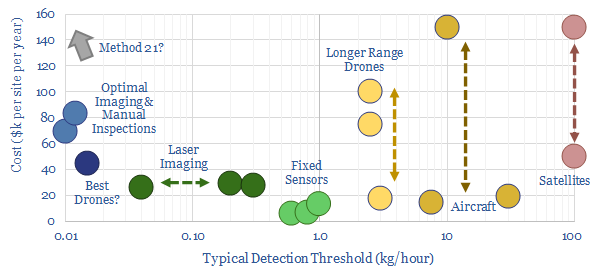Scaling up natural gas is among the largest decarbonisation opportunities on the planet. But this requires minimising methane leaks. Exciting new technologies are emerging. This 30-page note ranks producers, positions for new policies and advocates developing more LNG. To seize the opportunity, we also identify c25 early-stage companies and 10 public companies in methane mitigation. Global gas demand should treble by 2050 and will not be derailed by methane leaks.
This overview note was first published in 2019, then updated in Feb-2021 and September-2022, to add further case studies, companies and market updates. It contains all our latest views on methane mitigation, in a single, comprehensive resource.
Pages 2-5 explain why methane matters for climate and for the scale up of natural gas. If 3.5% of methane is leaked, then natural gas is, debatably, no greener than coal.
Pages 6-9 quantify methane emissions and leaks across the global gas industry, including a granular breakdown of the US supply-chain, based on asset-by-asset data.
Pages 10-11 outline the incumbent methods for mitigating methane, plus our screen of 34 companies which have filed 150 recent patents for improved technologies.
Pages 12-13 outline the opportunity for next-generation methane sensors, using LiDAR and laser spectroscopy, including trial results and exciting companies.
Pages 14-15 outline the opportunity for next-generation methane sensors, using AI and other ambient data, with a case study that likely offers detection costs below $10/ton CO2e.
Pages 16-18 cover the best new developments in drones and robotics for detecting methane emissions at small scale, including three particularly exciting companies.
Pages 19-20 outline next-generation satellite technologies, which will provide a step-change in pinpointing global methane leaks and repairing them more quickly.
Pages 21-27 cover the changes underway in the oilfield supply chain, to prevent fugitive methane emissions, highlighting interesting companies and innovations.
Pages 28-29 screen methane emissions across the different Energy Majors, and resultant CO2 intensities for different gas plays.
Page 30 advocates new LNG developments, particularly small-scale LNG, which may provide an effective, market-based framework to mitigate most methane.
Our underlying data-files into methane mitigation are also available to be viewed individually, in chronological order, covering company screens, technology reviews and leakage rate data.
